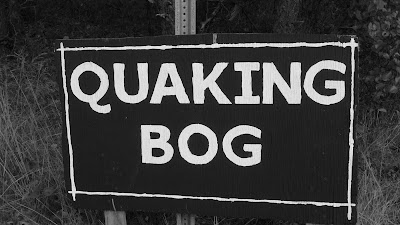
Smudge is among six artists who have created site-specific works in Provincetown, MA for the fourth annual Quaking Bog installation. The works ranged from conceptual to "restorative" to whimsical, and from entirely composed of found materials at the site to deliberately introduced "artificial" materials that commented on how people relate to landscape.
Provincetown is well known as one of America's earliest and preeminent artist colonies. Its natural beauty, remoteness, and acceptance of eccentricity and difference has inspired generations of fine artists, playwrights, photographers, and performance artists.
While much of the work that artists make here responds to Provincetown's dunes, beaches, and light, and many of its artists express concerns for its fragile environments, this small town at the tip of Cape Cod's spiral of sand hasn't been particularly known for "land art."
For four years, the annual Quaking Bog installation has challenged artists to create site-specific work suitable for the scale, fragility, and unique eco-systems surrounding this, the world's largest quaking bog located on a seacoast. Located just outside of Provincetown, the bog was purchased by the town to preserve it from development. In a town that thrives on luring visitors from around the world via a calendar filled with special weekends and week-long themed events, the Quaking Bog installation is a relatively intimate and local project. There is a palpable sense in this installation of the artists' own intimacies with the natural forces of the Provincelands, including the forces of its landscape.
Frank Vasello organized Quaking Bog IV, created one of this year's works, and hosted the artist walk-through on a brilliant October day, October 11. Each of the artists took turns presenting their works to a group of about 20 visitors who walked from site to site.
The Provincetown Quaking Bog Art Installation remains until the end of October.
(Click photos to enlarge)

 Paula Draper's "Spiritual Tree Healing." Artist statement:
Paula Draper's "Spiritual Tree Healing." Artist statement: Dead bottom branches on living trees are wapped in strips of sheeting to resemble bandages. the idea is adapted from the Shinto Shrines in japan where parents tie bibs with wishes for their sick childrens' health on rock and then ring a bell for the Kami to heal their children.

 Connie Hatch's "Vessels." Artist statement:
Connie Hatch's "Vessels." Artist statement:Plant materials and rusted metals exhibit the muted colors of this season in abundance all around us. I tried to contain them for a bit of time.

 David Bastien's "Weather Vane." Artist Statement:
David Bastien's "Weather Vane." Artist Statement:Natural material, primarily thin sapling wood, is used to create a 'drawing in space' that will turn with the wind.
 Hannah Verlin's "Agro-Culture." Artist Statement:
Hannah Verlin's "Agro-Culture." Artist Statement:We humans have a strange--almost estranged relationship with nature. We might embrace it, but only on our terms. Think of public parks that are designed to look wild, or manicured paths running through woodlands. This installation will explore how we attempt to both tame and cultivate the wild.
 Frank Vasello's "Nautilus." Artist Statement:
Frank Vasello's "Nautilus." Artist Statement:Using sticks gathered on site, this sculpture seeks to invoke a feeling of movement from what are normally static materials. Originally thought of as a nautilus, the piece evolved into the form you see before you.

 tsmudge studio's "Signals from the Deep." Artist Statement:
tsmudge studio's "Signals from the Deep." Artist Statement:This piece is a creative response to the meeting of geologic, biologic and atomic forces. These forces make the deep past, present, and deep future of Provincetown's Quaking Bog. A peat-moss sculpture and take-away "newsprint" invite visitors to expand their capacities to sense and live in relation to geologic time.
Read the newsprint here.






No comments:
Post a Comment
Note: Only a member of this blog may post a comment.